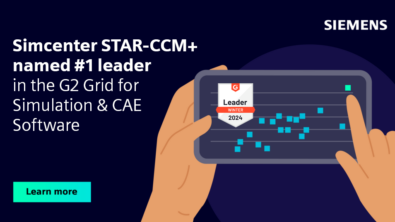The State of Simulation 2018: Lessons from the Simcenter Conference


I just got back from the US Simcenter Conference in Detroit, most of which I spent locked in a small room interviewing attendees on video about their experiences with our products, and of the conference. This was an inspiring and emotionally exhausting experience and I was overwhelmed by the level of enthusiasm and passion that exuded from every interviewee, both for their own simulation projects and for the wider simulation community that they experienced at the conference.
I’ve been attending events like these (mostly the STAR Global Conference) for most of the last 25 years, and because they occur annually they offer a good opportunity for me to sample the current state of engineering simulation in industry. We have come a very long way.
Of course, you don’t have to take my word for it. You can download a large number of presentations from the conference from the Simcenter Community (links below) and draw your own conclusions. If you are quick you could also register and attend the Simcenter Conference in Prague which takes place in December and promises to be even bigger and better than the Detroit event.
In no particular order, here are some of the lessons I learned from my conversations at the Simcenter Conference:
- Single point simulations are dead: when we first started talking about “Design Exploration” about five years ago it seemed like an aspiration rather than a useful tool. Back then, although almost everyone described an intention to investigate more design variations of their products, they had neither the tools nor resources to build design exploration studies into their standard process. Today it seems as if, having gone to the trouble of building a simulation model, almost EVERYONE is running hundreds, if not thousands of design variations. This is a fundamental change in the way simulation is deployed, and the influence that it has on product design.
- Simulation is no longer the sole domain of big corporations: whereas 10 years ago, most of the companies represented at these conferences were huge corporations, it was clear in Detroit that simulation is now penetrating all sizes of companies, including many “start-ups” whose entire business model is based upon extensive simulation, including innovative products that would be impossible to bring to market otherwise.
- Simulation is not killing test: although people like me spent the early part of their careers predicting that engineering simulation would lead to a reduction in the experimental testing of physical prototypes, as we approach 2019 certain parts of the testing industry and thriving because of simulations. Put briefly, “simulation for the test” is now a thing, as extensive CFD, FEA, acoustic and system simulation allow companies to test more intelligently, and extract more information from these experiments (including simulation to determine the location of measurement sensors.
- Innovation comes from cross-pollination: I wrote about it extensively here, but my conversations at the Simcenter Conference confirmed that although you can learn lots from peers in your own industry, the greatest value can be extracted from learning from experts in other industries, learning from best practice and taking inspiration from similar (or very sometimes very different) applications elsewhere. Of course, since the conference is streamed by the industry you could spend the entire event learning from people inside your own industry if you so choose.
- There are no easy problems left to solve: Solving complex industrial problems requires simulation tools that span a multitude of physical phenomena and a variety of engineering disciplines. Real-world engineering problems do not separate themselves into convenient categories such as “aerodynamics”, “hydrodynamics”, “heat transfer” and “solid mechanics”. Only multidisciplinary engineering simulation can accurately capture all of the relevant physics that influence the real-world performance of a product While the previous events (such as the STAR Global Conference, and LMS and Mentor Conferences) were usually focused on a small subset of CAE and Test solutions, the Simcenter Conference was the first event that brought the complete Simcenter Portfolio together in a single mammoth event. The people that I interviewed were excited about the wider scope of the conference, and the ability to learn about the other simulation tools and testing solutions
- Building community: This used to be called “networking” but it has become much more than that, I witnessed customers (and Siemens employees) establish career-long relationships that strengthen their commitment and dedication to our simulation and testing solutions. Some of these were formed over coffee and lunch breaks. Others were lubricated by generous amounts of alcohol consumption at the evening events and receptions.
All of the presentations are available on the Event Collateral page under the Simcenter Conference Americas 2018 label. Here are links to the individual presentations:
General Session
Simcenter Portfolio Technology Update
Jean-Claude Ercolanelli, Vice President, Simcenter Computational Continuum Mechanics
Track 1: Automotive
Changan US R&D Center: V2V Platooning
American Axle: Predicting Thermal Behavior of a Wet Clutch System Using a 1D/3D Coupling Approach
Magneti Marelli: Defogging Simulation of an Automotive Headlamp Using CAD
Ford: Realistic Brake Cycle Simulation
Grakon: Heatsink optimization inside of a fog lamp using Simcenter STAR-CCM+
Ford: High Fidelity System Modeling for Hybrid Driveline Dynamics
Track 2: Aerospace & Defense
TLG Aerospace: Successful Applications of CFD within the Aircraft Certification Process
Bell Helicopter: Bell V-280 Valor Hydraulic System Optimization for Accelerated Development
Kratos: Rocket Booster Separation from a UAV Using Simcenter STAR-CCM+
Maya HTT: Improving stability and performance of flight controls
Design Automation Associates: Digital Thread for Simulation & Test
Track 3: Industrial Machinery & Energy
Caterpillar: Democratizing the Creation of Detailed Bolted Joint FEMs using NX Open Apps
B&B-AGEMA GmbH: Design Exploration of High Efficient Steam Turbine Airfoils
Maya HTT: Simcenter Multiphysics Workflow for BGA and Creep Solder Reliability
Cummins: Multi-Attribute Optimization of Industrial Machinery by System Level Modeling
Track 4: Consumer Products & Retail, Electronics, Medical Devices
Conagra Brands: Modeling of Sterilization of Food Particulates in Continuous Retort
Whirlpool: Icemaker Flow and Cooling Optimization
Iceotope: Unique High-Performance Immersion Liquid Cooling Solution for 1U Profile Servers
Saratech: A Comparison of Implicit and Explicit Solutions for Electronics
Mercury Racing: FloEFD: CFD Tool Which Has High Affinity with PLM software
Improving Sound Quality of Digital Assistants Through Simulation
Track 5: Simcenter Product Updates
Product Overview and What’s New Simcenter STAR-CCM+
Product Overview and What’s New Simcenter solutions from Mentor, A Siemens Business
Product Overview and What’s New Simcenter solutions from TASS International, A Siemens Business
Product Overview and What’s New Simcenter 3D
Product Overview and What’s New Simcenter Testing Solutions
Product Overview and What’s New Teamcenter Simulation
Product Overview and What’s New HEEDS
Product Overview and What’s New FEMAP
Product Overview and What’s New Simcenter System Simulation


